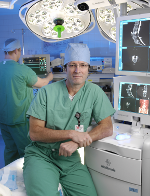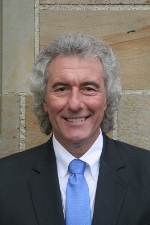 The digital age is evolving quickly in healthcare and spine surgeons are beginning to develop advanced technology for computer modeling. Collaboration between scientists and clinicians at The Ohio State University has
The digital age is evolving quickly in healthcare and spine surgeons are beginning to develop advanced technology for computer modeling. Collaboration between scientists and clinicians at The Ohio State University has  produced a unique modeling program that allows surgeons to view a three-dimensional image of patients preoperatively to understand where the weaknesses are before the procedure begins.
produced a unique modeling program that allows surgeons to view a three-dimensional image of patients preoperatively to understand where the weaknesses are before the procedure begins.
"The thing that makes our modeling unique is that we can do it for individual patients," says William S. Marras, PhD, CPE, Honda Professor in the Department of Integrated Systems Engineering at The Ohio State University and Institute Director & Scientific Director of the Spine Research Institute. "We can take CT or MRI scans and turn them into solid models. We can compute forces experience by the various tissues, muscles and bones. We have gotten accurate — down to a fraction of a millimeter in accuracy — and then we sit down with the physician and he'll tell us what he's doing to see what works and what doesn't."
With the personalized model, the surgeon can perform a virtual procedure. "It's a huge clinical tool for us to use," says Ehud Mendel, MD, Professor in the Department of Neurological Surgery, Justine Skestos Chair in Minimally Invasive Neurological Spine Surgery, Spine Program Director and Clinical C-Director of the OSU Spine Program at The Ohio State University Wexner Medical Center. "It makes the surgery quicker because we don't need to use a cadaver to try the instrumentation. We can take the instrumentation and implant it in the patient model, see where the weak parts are and strengthen it."
Computer modeling can be used on simple as well as complex tumor or deformity cases. The technology is currently in the developmental phase and researchers at Ohio State's Wexner Medical Center are conducting prospective studies on patients to figure out where the technology predicts well and where it doesn't.
"We want to predict adjacent level disease or other problems down the line," says Dr. Marras. "We can predict their status in the moment, but our goal is to project that into the future and figure out where they'll be two or 10 years down the line."
While there are a lot of people doing modeling today, two things making this project unique are the personalization and ability to "bend" and "twist" to see how the patient's spine will react to loads they experience in their daily living. Spine surgeons in the future could use this technology to further personalize assessments.
"That's what we're aiming for down the road, and it's going to get more quantitative," says Dr. Marras. "The model enables you to put numbers into what the surgeon sees. Once we have that model, we can make three-dimensional printings of the patient's spine so the surgeon can actually hold it in his hands before drilling and inserting screws into the patient's spine."
Dr. Mendel performs many spine tumor cases and has found using the computerized modeling especially advantageous for those cases. He performs the surgery on the computer model to remove the tumor and then works with the program to figure out how to reconstruct the patient's specific spine with instrumentation.
"In the tumor arena, that's an extremely valuable tool," says Dr. Mendel, who is also a member of The Ohio State University Comprehensive Cancer Center – Arthur G. James Cancer Hospital and Richard J. Solove Research Institute. "It's also helpful for the patients. We can show them their own spine in the three-dimensional view and show them how we'll do the procedure. It makes a huge difference from the patient's point of view."
More Articles on Spine Surgeons:
Minimally Invasive vs. Open Spine Surgery: Where the Field is Headed
Iliac Bone Crest vs. Synthetics for Spinal Fusion & Beyond: The Biggest Opportunities in Spinal Biologics
Compensation for Full-Time Neurosurgeons: 4 Statistics

